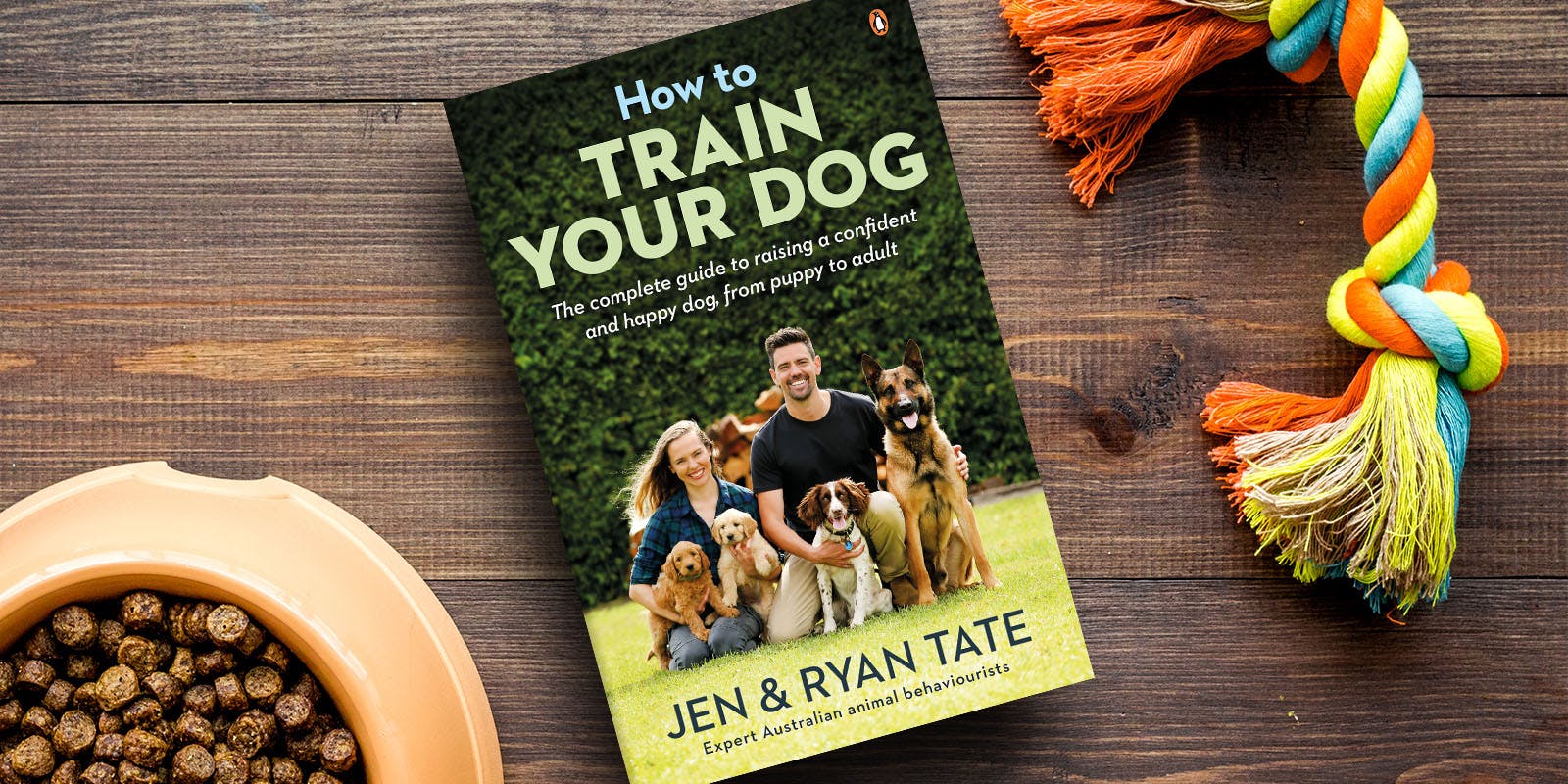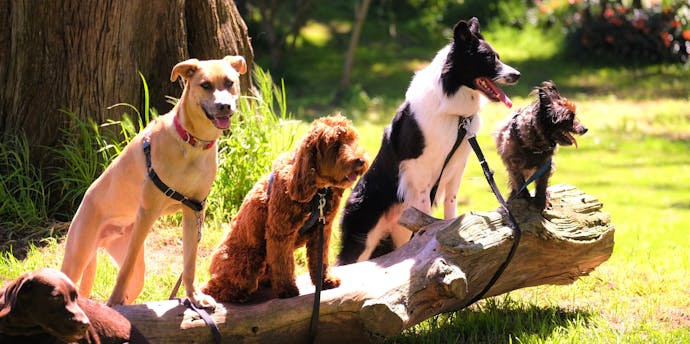Australia’s leading animal behaviourists on raising a calm, confident puppy.
Authors Jennifer and Ryan Tate are passionate about animals and expert dog trainers. Together they run Tate Animal Training Enterprises and once set a world record with their Australian Shepherd, Ari, for the most dog tricks in under a minute (38!).
With pet adoptions soaring in 2020 many families welcomed a dog into their lives. The Tates write in the introduction to How to Train Your Dog, 'the fact that more people are living in smaller homes in denser, busier suburbs creates new challenges that can make living with a dog more complex than it once was.Training your dog is the best way you can give back to these magnificent creatures.'
Read on to find out how you can set your dog up for success and develop the independence and resilience they need to thrive, whether you're home 24/7 or have a busy schedule.
What Do We Mean by ‘An Independent Dog’?
An independent dog is social and outgoing, but also has the ability to switch off and relax anytime, anywhere, if her physical and psychological needs have been met. The goal is to raise a dog who is content and comfortable with being left alone for periods of time and is also happy being looked after by friends and family. Sounds ideal, right?Dogs are gregarious creatures and, for the most part, aren’t naturally equipped to cope with long periods of time on their own. It doesn’t help that most of us live such busy lives, and school and work schedules mean a dog is likely to be left alone for anywhere between six to nine hours a day, on average (while this may be the norm, it is still a fairly long time for a social creature to be by themselves). We need to manage this and build resilience into our dogs to ensure loneliness and separation anxiety don’t start to develop.
How to develop independence in your puppy
What can you do, while your puppy is young, to help develop her independence and reduce the risk of distress when she’s left alone?
- If you work full-time, take an appropriate amount of time off when you bring your new puppy home. (We suggest a minimum of two weeks.) If you are home full-time, ensure the puppy is still experiencing short bursts of time separate from you – you never know, your situation might change and your dog needs to be able to deal with this. Whatever your circumstances we suggest you aim for at least two weeks of flexibility for your puppy to bond with you, but also gradually get accustomed to being left alone for longer periods of time (keep in mind that if she is 8 weeks old when you bring her home she has probably never been alone). Two weeks off work might seem like a big commitment, but these two weeks could save your dog from a lifetime of anxiety-related issues. Crate train your puppy at night. It’s the perfect middle ground between leaving your pup alone in the laundry and having her snuggle in bed with you. A crate by your bed for the first week helps your pup not feel abandoned or alone after leaving her littermates and mum. The crate becomes the comforting factor, rather than you and your bed, and eventually you can move the crate into another area. See later in this chapter for more information on crate training.
- Set up a ‘Puppy Space’ in the main action room of your house. When you are not training, supervising or playing with your puppy, put her in this area. The puppy begins to develop very necessary independent skills by virtue of not being able to follow you everywhere but she will still feel as if she is part of the action.
- Practise the cafe dog exercise, which we’ll cover later in this chapter.
- When you leave your puppy alone for the first few times, keep her in a smaller area rather than a large backyard, and aim for short stints to begin with, gradually varying the duration she is left alone.
- Don’t make a big deal about leaving; be matter-of-fact. Combine walking out the door with giving your puppy breakfast or some other enrichment. When you return, as hard as it is, refrain from beelining for puppy cuddles the minute you walk through the front door. Instead, calmly say hello and then unpack bags or do whatever else you need to do. Once your pup has resettled with you being home, then you can go bananas with the greeting.
- Enrichment. One thing puppies love just as much as social interactions and companionship is food! Feed her at times when she is experiencing separate time and give her lots of food-based enrichment when outside, penned or crated to make time away from family worthwhile (see ‘Behavioural Enrichment’ on page 121).
- When your puppy is experiencing any form of separation time, keep a calm and relaxed disposition yourself, especially if she seems frustrated or distressed. Emotions are contagious and she can feed off your relaxed state.
Common Situations to Avoid in the First 6 to 12 Months
To help encourage independence, try to steer clear of the following:
- Sleeping in bed with your puppy – We are fine with well-adjusted adult dogs sleeping on your bed, but if they start off with this sleeping arrangement as young puppies, they will struggle to cope with sleeping anywhere else in your home, let alone a friend’s house if you decide to go on holidays.
- Letting your puppy follow you around the house all the time – A sure-fire way to fast-track separation distress or anxiety is allowing your puppy to follow your every move while she is young. We go by the rule of thumb that if you are not training, playing with or supervising your puppy, she should be experiencing some form of independent time.
- Letting another dog keep your puppy company when you are busy – It’s very easy to let an older dog babysit the new puppy, to prevent distress when left alone. But this means the puppy will not develop an independence of her own and will instead become reliant on that other dog to feel comfortable and safe.
- Too much alone time too soon – In order to help a puppy feel comfortable with being alone, it’s important to gradually build her tolerance to being separated from you and the family. Throwing her in the deep end and just letting her ‘get over it’ or ‘grow out of it’ rarely helps build independence long term. Every dog’s ability to handle alone time is individual and needs to be catered to accordingly. As we’ve mentioned before, you really can’t expect a puppy to tolerate a whole day at home alone within two weeks of leaving her litter. So you might want to engage a friend or neighbour to do some puppy sitting or visits throughout the day.
- Strict routines – Humans by nature form routines. As we mentioned in Chapter 2, they can also be beneficial to a dog so long as there is a bit of flexibility. Things like meal times, walks and exercise, bed time and the time a puppy is let out in the morning should be variable. If you like strict routines, even just changing them by 10 minutes or so here and there is a good idea. Why? Life isn’t going to remain in that routine forever – humans change living arrangements, jobs and lifestyles. A puppy who has learned a fixed routine in her first year of life struggles to adapt to a new one down the track. If you consistently follow through with an activity at the same time each day, your dog will absolutely be able to tell the time and expect that activity at that time. Then, if you suddenly try to change the timing it can result in some protest from your dog.
If you can resist all these things, you’ll already be on the road to raising a dog who’s comfortable in her own company.














